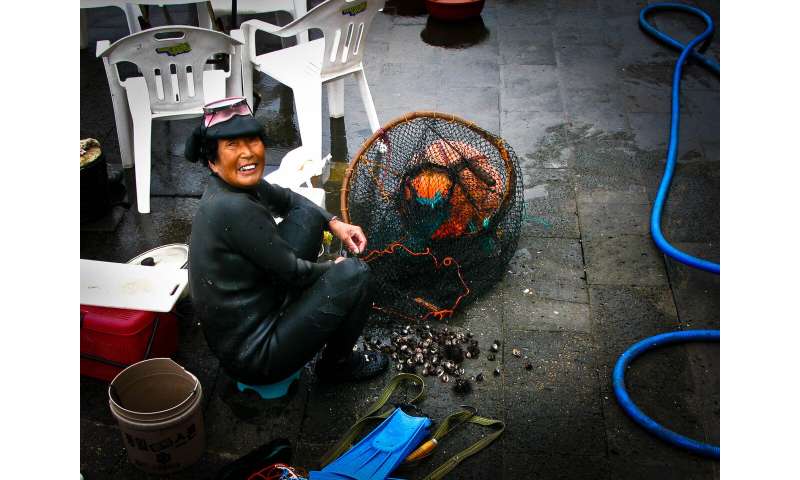HERSTORY
Fisherwomen contribute tons of fish, billions of dollars to global fisheriesby Valentina Ruiz-Leotaud | Sea Around Us

Haenyeo, woman diver of Jeju Island, South Korea. Credit: Andrew Trites.
Women's fishing activities around the world amount to an estimated 3 million tonnes of marine fish and other seafood per year, contributing significantly to food and livelihood security in all regions of the world. However, these contributions often go unnoticed.
A new study by researchers at the University of British Columbia aims to address this oversight by assembling and presenting the first global-scale quantitative estimates of catch by women and the associated value of what is brought to shore.
"We used a variety of sources, from national databases and local experts, to peer-reviewed and newspaper articles, in order to estimate how much women are catching in all countries and regions," said Sarah Harper, lead author of the study and a postdoctoral fellow with the OceanCanada Partnership and the Fisheries Economics Research Unit at UBC's Institute for the Oceans and Fisheries. "We calculated the value of those 3 million tonnes of seafood that women are catching to be around $5.6 billion per year, or the equivalent of 12% of the landed value of all small-scale fisheries catches globally."The fish and invertebrates that women catch go toward feeding themselves and their families, with some also sold in local markets. This means that the economic impact of these catches goes beyond the initial sale in the market, adding up to some $17 billion per year.
"And if we adjust these values to account for the variation between countries in purchasing power, the economic impact of women's catches is closer to $26 billion," Harper said. "Although there is increasing attention worldwide to the role of women and gender in fisheries, these numbers further emphasize the significance of the contributions by women in a sector where their work continues to be overlooked and undervalued."
Women in Asia, Africa, and Oceania were found to have the highest rates of participation in fishing activities. Overall, 2 million women participate in near-shore coastal fisheries worldwide using low-technology fishing gear.
"For many people, the numbers may come as a surprise. Fishing has long been considered a strictly male sphere. There has been such a lack of attention to the role of women in fisheries that some fisherwomen prefer to call themselves 'fishermen' so that their contributions count as much as those of their male counterparts," said Daniel Pauly, co-author of the study and principal investigator of the Sea Around Us initiative at UBC. "What happens, then, is that when you search for participation statistics, they show that there are no women in fisheries, which is not true."
For Rashid Sumaila, co-author of the paper and head of the Fisheries Economics Research Unit, the numbers highlighted in the study are especially significant in contexts where women's income goes disproportionately toward household provisioning and children's health and education.
"This study translates the important work of researchers who have been working on this topic for decades into the language of policymakers, where dollar amounts are often the currency for evaluating policy priorities," Sumaila said. "Thus, our hope is that these findings are used to design policies that promote women's participation in and contributions to the fisheries sector."
The study, "Valuing invisible catches: estimating the global contribution by women to small-scale marine capture fisheries production," will be published on March 4, 2020, in PLOS ONE.
Women's fishing activities around the world amount to an estimated 3 million tonnes of marine fish and other seafood per year, contributing significantly to food and livelihood security in all regions of the world. However, these contributions often go unnoticed.
A new study by researchers at the University of British Columbia aims to address this oversight by assembling and presenting the first global-scale quantitative estimates of catch by women and the associated value of what is brought to shore.
"We used a variety of sources, from national databases and local experts, to peer-reviewed and newspaper articles, in order to estimate how much women are catching in all countries and regions," said Sarah Harper, lead author of the study and a postdoctoral fellow with the OceanCanada Partnership and the Fisheries Economics Research Unit at UBC's Institute for the Oceans and Fisheries. "We calculated the value of those 3 million tonnes of seafood that women are catching to be around $5.6 billion per year, or the equivalent of 12% of the landed value of all small-scale fisheries catches globally."The fish and invertebrates that women catch go toward feeding themselves and their families, with some also sold in local markets. This means that the economic impact of these catches goes beyond the initial sale in the market, adding up to some $17 billion per year.
"And if we adjust these values to account for the variation between countries in purchasing power, the economic impact of women's catches is closer to $26 billion," Harper said. "Although there is increasing attention worldwide to the role of women and gender in fisheries, these numbers further emphasize the significance of the contributions by women in a sector where their work continues to be overlooked and undervalued."
Women in Asia, Africa, and Oceania were found to have the highest rates of participation in fishing activities. Overall, 2 million women participate in near-shore coastal fisheries worldwide using low-technology fishing gear.
"For many people, the numbers may come as a surprise. Fishing has long been considered a strictly male sphere. There has been such a lack of attention to the role of women in fisheries that some fisherwomen prefer to call themselves 'fishermen' so that their contributions count as much as those of their male counterparts," said Daniel Pauly, co-author of the study and principal investigator of the Sea Around Us initiative at UBC. "What happens, then, is that when you search for participation statistics, they show that there are no women in fisheries, which is not true."
For Rashid Sumaila, co-author of the paper and head of the Fisheries Economics Research Unit, the numbers highlighted in the study are especially significant in contexts where women's income goes disproportionately toward household provisioning and children's health and education.
"This study translates the important work of researchers who have been working on this topic for decades into the language of policymakers, where dollar amounts are often the currency for evaluating policy priorities," Sumaila said. "Thus, our hope is that these findings are used to design policies that promote women's participation in and contributions to the fisheries sector."
The study, "Valuing invisible catches: estimating the global contribution by women to small-scale marine capture fisheries production," will be published on March 4, 2020, in PLOS ONE.
Billions lost as illicit fisheries trade hurting nations who can afford it least
More information: Harper S, et al. 2020. "Valuing invisible catches: estimating the global contribution by women to small-scale marine capture fisheries production" PLOS ONE journals.plos.org/plosone/arti … journal.pone.0228912







/cdn.vox-cdn.com/uploads/chorus_image/image/66433499/GettyImages_1209884056.7.jpg)
/cdn.vox-cdn.com/uploads/chorus_image/image/66439313/GettyImages_1205027208.0.jpg)
:no_upscale()/cdn.vox-cdn.com/uploads/chorus_asset/file/19767192/GettyImages_1183466980.jpg)
:no_upscale()/cdn.vox-cdn.com/uploads/chorus_asset/file/19767207/GettyImages_1205048507.jpg)